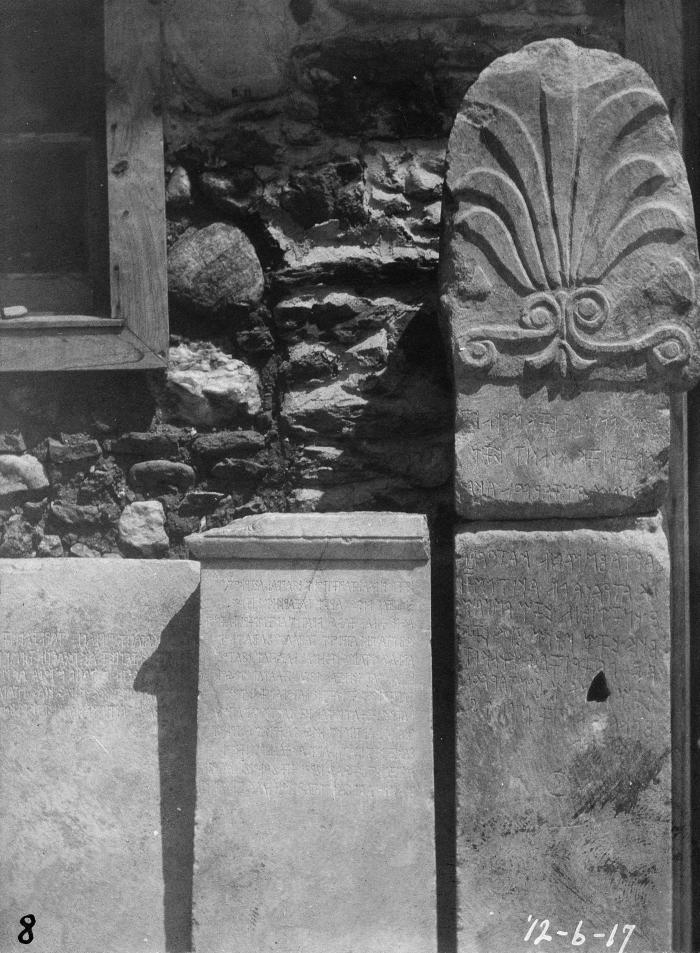Palmette ile Sepulchral Stel'in bir kısmı
- Dönem
- ca. 420-400 BC, Geç Lidya (Pers)
- Müze
- İzmir, Arkeoloji Müzesi, 695
- Müze Envanter No.
- 695
- Sardeis veya Müze Env. No.
- Izmir 695
- Malzeme
- Mermer, Taş
- Eserin Türü
- Heykel
- Heykelin Türü
- Stel
- Yerleşim
- Sardis
- Alan (Sektör)
- Nec
- Locus
- Nec Wall with Lydian Stelai
- Bulunduğu Yeri
- Found in a late wall on N slope of Necropolis hill with 12 other inscriptions including Lydian-Aramaic bilingual (
Cat. 241 Fig. 420) therefore reused, cf. Sardis VI, 2, 1, for location (May 24-25, 1912).
- Tanım
The stele has an oval finial, seven-petalled palmette on antithetic horizontal spirals, and downward-pointed small lotus. The anthemion projects slightly to the spectator's r. "The lateral projection ... was probably next to the dromos, whereas the straight side and the back of the stele lay against the hard earth in which the dromos had been cut. The stele would have stood . . . on the left" of anyone approaching the dromos (ibid., 15).
Möbius justly places the stele under the "rich Erechtheion style," but it seems to me earlier than the crowning anthemion of the Lydian-Aramaic bilingual of 394 B.C. because of the more conservative form of the palmette and lack of acanthus. The palmette of Cat. 240 resembles those of the Satrap Sarcophagus of ca. 430 B.C. (Möbius Ornamente Grabstelen 1929, 11, n. 28, pl. 1c; cf. pl. 5a, Apollo temple, Delos, 425-417 B.C., and pl. 6; Möbius, Ornamente Grabstelen 1968, addenda p. 103) and would be dated ca. 420-400 B.C.
The inscription begins 0.05 below the anthemion and covers a H. of 0.50 in twelve lines. The fourth line is lost in the break between the upper and lower pieces of the stele. The following is from the German translation by R. Gusmani (by letter):
This grave chamber and this stele and this/ dromos (?) and whatever to this/ (grave) chamber may belong, now this is (of ....) (the son) of Artabanas and of Katovas/ (the son) of Atrasas; now whosoever damages this grave chamber/ or this stele or this/ dromos (?) and whatever/ belongs to this grave chamber/ now him Pious(?) . . . . ./ will punish.
- Condition
Large-crystalline grayish marble, "local."
Found by Butler in two joining parts; only top part seen in lzmir in 1971; for original condition cf. Sardis VI, 2, 15, ill.
- Boyutlar
- Entire stele (first Sardis expedition): H. 1.79; W. of decorated part 0.39, of straight shaft 0.32; Th. of upper part 0.185, of shaft 0.175. Present condition: P.H. of upper part 0.73, of anthemion 0.51.
- Yorum
- Ayrıca bakınız
- Kaynakça
- Published: Sardis I,161, ill. 179; Sardis VI, 1, L. 9, ill.; Sardis VI, 2, 15f., ill, no. 8, pl. 4; Möbius, Ornamente Grabstelen, 24, n. 26, pl. 9a; Gusmani, Lydisches Worterbuch, no. 8, with full inscription; idem, Lydiaka, 272.
- Yazar
- NHR

